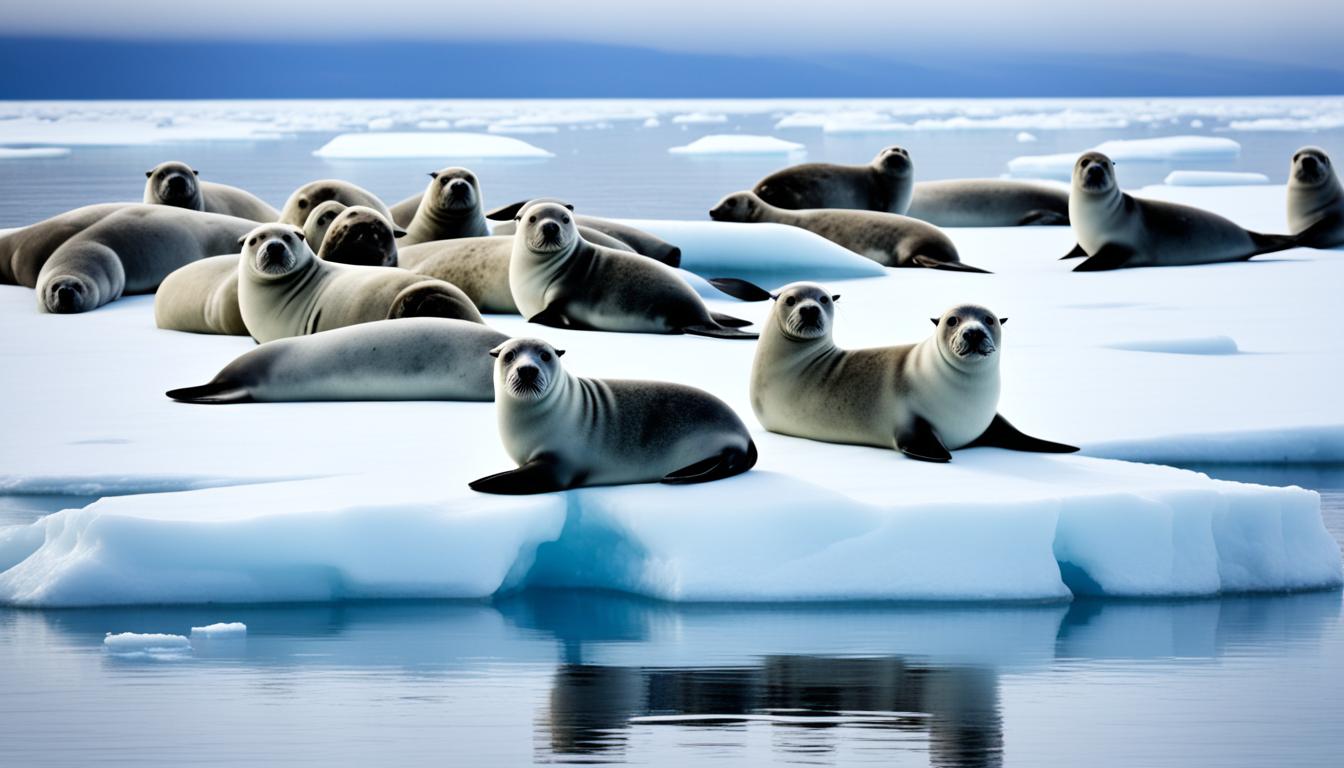Have you ever wondered if seals are endangered? These amazing sea creatures belong to the group Pinnipedia. They include eared seals, earless seals, and walruses. With 33 types worldwide, knowing if they are endangered is key.
Many threats, like climate change and losing their homes, put their survival at risk. This makes protecting endangered seals more important than ever.
Understanding the need to save seals is vital. It helps us learn more about the ocean and its creatures. We must act to keep the ocean healthy for all.
Understanding Seal Species and Their Habitat
Seals are amazing marine mammals found all over the world. Knowing about their species and where they live is key to protecting their homes. This part will give you a closer look at the different types of seals and where they live.
Overview of Seal Families
Seals belong to three main families, each with its own special traits:
- Eared Seals (Otariidae): These seals have ears and can walk on land using their flippers. This lets them move around on land more easily.
- Earless Seals (Phocidae): Without ears, these seals drag themselves on land. This affects how they live.
- Walrus (Odobenidae): Famous for their big tusks, walruses live in groups and have their own favorite places to live.
The looks of these families help them adapt and live in their environments. Knowing how many seals there are helps us understand the problems they face.
Seal Habitats Around the World
Seals live on every continent, mostly in the ocean. Some like cold water, while others, like the Hawaiian monk seal, live in certain areas only. They need both land and water for resting, breeding, and finding food. Where they choose to live is key to their survival and how well they can reproduce.
Seals like to stay in:
- Rocky shorelines
- Sea ice areas
- Protected bays and beaches
These places are important for keeping warm and raising their young. With changes in the environment, it’s more important than ever to protect their homes to keep their numbers stable.
Are Seals Endangered? Current Population Status
Understanding the current population status of seals shows how vulnerable they are. The International Union for Conservation of Nature (IUCN) lists species based on their risk levels. This highlights the threats different seal species face.
Categories of Endangerment Based on IUCN Red List
The IUCN Red List puts species into categories from least concern to extinct. Seals vary in risk, with some doing well and others in danger. Their risk depends on their habitat and where they live. Knowing these categories helps us focus on saving endangered seals.
Notable Endangered Seal Species
Among 33 seal species, many are in danger. The Mediterranean monk seal is the most threatened. Others include the Hawaiian monk seal, the Galapagos fur seal, and the Caspian seal.
The Hawaiian monk seal is critically low, with only about 1,600 left. Its decline is due to less food and losing its home.
Threats to Seal Populations
Understanding the challenges seals face is key to their future. Many factors threaten their numbers, making it hard to protect them. We’ll look at two big threats: climate change and commercial hunting.
Climate Change and Its Impact on Seals
Climate change is a big threat to seals worldwide. Sea ice is crucial for their breeding and resting. Without it, they struggle to survive.
Changes in ocean temperatures also affect their food supply. This makes it harder for seals to eat. Plus, rising sea levels and more human activity damage their homes.
Commercial Hunting and Bycatch
Commercial hunting has greatly reduced seal numbers before. Even with rules now, illegal hunting is still a problem. Bycatch, catching seals by accident in fishing gear, also hurts their cause.
Seals get tangled in nets and other equipment, leading to many deaths. This harms different species and makes saving endangered seals harder.
Conservation Efforts for Seals
Significant strides are being made in conservation efforts for seals. These efforts aim to protect endangered seals and ensure their populations remain viable. Legal frameworks and organizational initiatives play vital roles in this mission.
Legal Protections for Seals in the United States
The Marine Mammal Protection Act gives strong legal protections to all seal species. This law sets strict limits on hunting and destroying their habitats. Species like the Hawaiian monk seal get extra protection under the Endangered Species Act.
This law helps reduce human impacts and supports recovery plans. These are crucial for the survival of these vulnerable animals.
Organizational Initiatives and Research
Many organizations help with seal conservation through research and public awareness. The National Oceanic and Atmospheric Administration (NOAA) and the Marine Mammal Center lead in this effort. They gather data to inform conservation strategies.
Their research includes community engagement. This helps build a culture of marine conservation. These efforts aim to protect seal populations and teach the public about the need to protect endangered seals.

| Organization | Key Initiatives | Impact on Seal Conservation |
|---|---|---|
| NOAA | Research on seal habitats and populations | Informs regulatory decisions and recovery plans |
| Marine Mammal Center | Rescue and rehabilitation programs | Directly boosts seal population recovery |
| SeaWorld | Educational outreach and conservation funding | Raises public awareness about seal issues |
Ways to Save Seals and Their Habitats
Protecting seals and their homes is crucial. You can help by joining efforts to spread the word and protect their homes. Every action you take can make a big difference.
Public Awareness and Education Campaigns
It’s key to tell people about seal conservation. Campaigns teach communities about the danger seals face and why their homes matter. They cover:
- The need to save marine ecosystems.
- Learning about seal behavior and their role in nature.
- Understanding threats like climate change and pollution.
By learning, you can teach others. This helps build a big group working to protect these sea creatures.
Participating in Conservation Programs
Joining conservation efforts is a direct way to help seals. You can help by:
- Volunteering at places that help injured seals.
- Giving money to research on seal populations.
- Helping with projects that make better homes for seals.
Your actions really matter. They can help seals and their homes a lot.
Future of Seal Conservation
The future of seal conservation depends on many things. We need ongoing research, strong laws, and more people getting involved. Climate change is changing marine ecosystems, and human actions affect wildlife too. We must act now with new and flexible conservation plans to help seals.
Working together across the world is key for seal conservation. By joining forces, we can tackle the big challenges seals face. Also, making fishing sustainable can help reduce the risk of bycatch, a big problem for seals and other sea creatures.
Getting people involved and teaching them about seal conservation is crucial. You can help by joining local groups that spread the word and support laws that protect the sea. Together, we can make a big difference and help seals live in a healthy ocean.










